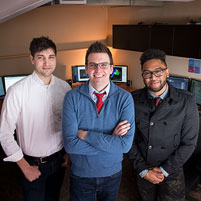The CoAx Lab
By Carillon Skrzynski

In the Cognitive Axon Lab, or “CoAx lab” for short, Timothy Verstynen and his lab members study the structural and functional aspects of the brain—why the brain is wired the way it is and how this wiring is related to cognition. Specifically, the lab investigates the brain systems involved in selecting motor actions and how these actions are integrated to form a complex skill.
Verstynen, assistant professor of psychology, explained, “It’s like playing the piano. Each key press is an individual action, but how does the brain learn to smoothly bind them into a sonata?”
The lab members pursuing this interesting question consist of one lab coordinator, three undergraduate students, three graduate students (two from the University of Pittsburgh) and one post-doctoral scholar. It’s a “familial lab” setting in which undergraduates are mentored by a senior lab member. Through one-on-one meetings, they learn the necessary methods for their projects and are guided in a mix of research and education creating an open dialogue between lab members.
"What I love most about my experience in the CoAx Lab is the diversity of expertise among our members in neuroimaging, computational modeling, and of course, cognitive neuroscience and psychology. It creates an invigorating intellectual atmosphere where unique perspectives converge to provide new solutions to the research questions we all share," said Kevin Jarbo, a second year graduate student.
The mix of research and education within the lab is not unlike a new research methods class that Verstynen designed. The course fulfills a requirement in the recently launched neuroscience undergraduate major, a joint endeavor between the Dietrich College of Humanities and Social Sciences and Mellon College of Sciences. Through this hands-on laboratory class, students work with tools such as functional Magnetic Resonance Imaging to learn about the brain mechanisms that underlie intelligent behavior.
Beyond neuroimaging, the CoAx lab also uses computational models – building on Carnegie Mellon’s unique strengths in areas like machine learning and statistics – to better understand the data they collect using both structural and functional imaging. Verstynen’s collaboration with computational colleagues is something he loves about the university and his research. For example, he has recently submitted a research proposal with faculty from machine learning and from cosmology to explore the similar statistical structures of brain networks and galactic clusters.
“CMU is the only place I know of that this would be possible,” Verstynen commented, “and I feel like the proverbial kid in a candy store working here.”
As the birthplace of artificial intelligence and cognitive psychology, Carnegie Mellon has been a leader in the study of brain and behavior for more than 50 years. The university has created some of the first cognitive tutors, helped to develop the Jeopardy-winning Watson, founded a groundbreaking doctoral program in neural computation, and completed cutting-edge work in understanding the genetics of autism. Building on its strengths in biology, computer science, psychology, statistics and engineering, CMU recently launched BrainHub, a global initiative that focuses on how the structure and activity of the brain give rise to complex behaviors.